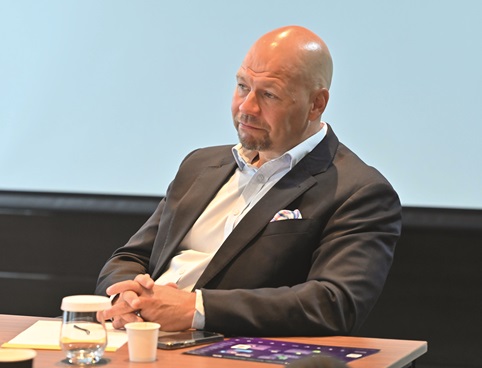Industry experts gathered for a roundtable organised by BroadcastPro ME and Cleeng in Dubai to discuss how to future-proof their OTT services.
In the relentless pursuit of profitability, OTT platforms contend for larger subscriber bases, less churn, better efficiency through automated processes and hyper-monetisation modules. By introducing more flexibility on the SMS side to support diverse business models such as hybrid monetisation alongside SVOD, and leveraging data insights collected from various touchpoints, platforms can better predict churn. Data insights become a valuable tool in deciphering operational strategies to sustain growth as platforms juggle workable mechanisms.

At a discussion on subscriber retention management, improving revenue streams and customer lifetime values, mitigating churn rates, enhancing cost efficiency and increasing ROI were explored and debated.
Moderated by Alexis Gai, SVP, Sales & Revenue, Cleeng, and Joachim Bergman, COO, Cleeng, the panel comprised Barry Mehdizadeh, Product Director, Shahid, MBC Group; Faraz Arshad, CTO, StarzPlay; Heba Al Samt, Awaan Manager, Dubai Media; Joe Al Khawand, Head of MENA Content Production, Yango Play; Karim Morgan, Head of Digital Technology, Asharq News; Melvin Saldanha, VP Technology, OSN; Nadine Samra, Chief Business Officer, Weyyak; and Peter Van Dam, COO, SPL Media House.
Drawing on the importance of profitability, Alexis Gai maintained that every strategy is valid depending on the phase that a company is at. Netflix and Disney invested heavily in subscriber growth before positioning themselves as dominant players. Although there is no secret recipe, players in the MENA region have looked for services to offer in the continuous search for new ways to generate revenue while optimising their TCO.

Profitability is an important element of any organisation, agreed Faraz Arshad, CTO of StarzPlay. “After a certain number of years, you have to show your investors if the desired profitability is coming in. At StarzPlay, we diversified our offerings; where we used to be VOD-centric, we shifted gradually towards live sport and now offer AVOD-, TVOD- and SVOD-based services.”
Whether privately owned or government-led, the goal is to be profitable; and as businesses grow, managing customers, their subscription, their churn and the cost of acquisition becomes demanding, and the need of a reliable technology provider is even more critical.

According to Melvin Saldanha, VP of Technology at OSN, the company’s primary focus lies in customer management, content consumption analysis, audience targeting via technology, and leveraging successful models of subscription video on demand (SVOD) and ad-supported platforms. He likened the current landscape to traditional TV of two decades ago, where there were limited channels, pay-per-view and TVOD (transactional video on demand). This historical cycle is now re-emerging in the OTT (over-the-top) realm. Saldanha emphasised the growing demand from advertising partners for integrating advertising revenue, indicating a collective industry shift in that direction, though he acknowledged that full realisation of this trend has not yet been achieved.
Different segmentations and multiple components come into play towards a possible profitable path, together with compliant and flexible subscriber management systems, all of which are possible in entertainment but much less so in live sport, countered Peter Van Dam. With prohibitive costs and multiplied renewal spend, sport is a different ball game.

“You have daily passes, monthly passes, event passes, and even that’s difficult because you want to see at the beginning of the season what you pay for, and against that you want to see subscriptions. The day passes they have in NFL for instance is a completely unique model, one that all leagues would love to have, but difficult.”
LTV on sport is not comparable to entertainment, and the moment a season or league is over people will churn, “unless a new league is happening within the same genre”, commented Arshad. “For us, it’s contributing to our profitability, which is why as a company we are investing in multiple leagues with the same genres.”
“In the realm of sports, particularly cricket, e-commerce platforms are forging partnerships and providing subscription services. Their aim is to merge streaming and e-commerce, effectively seeking to integrate the two experiences,” added Saldanha.

E-commerce platforms need live content, and with evolving consumer behaviour the future at a certain point will be people moving away from different apps and staying within one app – the aggregation of content from all partners into one ‘super app’. This app-level integration could modify metadata to present a library of prime content in one app with a single sign-on and single payment mechanism.
With many parts of the globe experimenting with the model, Dubai Media has been researching and testing a prototype.
“Super apps will come but there is the need to discuss rights, content acquisition, is it something we introduce today, will people accept it, would I want to read the newspaper on an OTT platform? Would I switch from a movie or a series to play a game? Many questions, and the audience is varied,” stated Heba Al Samt, “and they’re not looking for a service as much as something to keep them entertained.”
“At Weyyak, we’ve done successful productions and syndicated them for global visibility, but as a production house, the constant challenge is: what’s next?” – Nadine Samra, Chief Business Officer, Weyyak.
However, it’s about the seamless experience that comes with a super app, stated Yango Play Head of MENA Content Production Joe Al Khawand. “It’s a click away – one icon, one subscription, one single app. Movies, series, music, games within the same app and especially Yango Play, which is powered by AI. The result is a whole new connected experience.”
A diverse content library is inextricably linked to profitability and most platforms work around enhancing their body of content, aiming to effectively display and make that more accessible. Having exclusive content has its advantages to an extent, but not in the long run, pointed out Al Khawand.

“We produced a Saudi sitcom called Sakf El Waled during Ramadan and it did very well, and now we are exploring ways to make it more visible. We have a lot of talent – writers, directors, actors – and they want to be seen as much as possible.” That way, exclusivity is maintained for a while before opening the gate to partnerships to amplify everyone’s content spread.
“And adding another source of revenue at the end of the day,” said Karim Morgan, Head of Digital Technology, Asharq News. “Artists don’t care so much about the money as much as being seen, and if you limit their reach to a certain subset of platforms or audience, they will find somebody else to produce with.”
As OTT players explore viable models, have multiple rotating packages and more, the fundamental point is that there is no secret recipe. “That time when we were looking at OTT as an extra service, as a must-have because we needed our content to be viewed by audiences everywhere, that phase has gone. The objective right now is to make money,” said Nadine Samra. “At Weyyak we’ve done successful productions and syndicated them for global visibility, but as a production house the constant challenge is: what’s next?”

Barry Mehdizadeh, Product Director, Shahid, MBC Group, couldn’t have agreed more. “We have reached a certain maturity, a level where OTT is an entertainment commodity, a value-add service to another service, to a TV, a telco bundle, used by users as their main entertainment TV experience. And now, what’s the next innovation?”
He added that Shahid offers a full hybrid model beyond SVOD and AVOD “with a set of FAST channels”.
While challenges come, companies adopt new technologies to tackle churn and retention struggles. Data-centric companies look at data segmentation for their products and identify ‘golden cohorts’ through a mix of watch time and different pieces of content that they aspire to bring closer to all the other cohorts, to limit the probability of churn, said Gai. These insights can be turn into automated marketing campaigns to prevent churn or win back subscribers and maximise return on investment.

Planning profitability by acquiring more market share, businesses leaned towards profit optimisation or cost optimisation. Many OTTs fail because of cost that’s out of control. “Cost of content, whether acquisition or production; cost in marketing (unnecessary spend); and third, technology. If you can control the three, automatically you’ll see the light,” said Morgan.
“Cost optimisation becomes difficult as the content and platform delivery cost is getting expensive, not just for us but for all OTT players. Everything has changed – compute, storage, CDN and the costs never reduce, they only keep growing,” added Arshad.
Adopting a hybrid approach means optimising the CDN as well as acquiring quantum rights so that customers stay for a longer time. From a sports league standpoint, optimising income to create the best digital football experience for fans is crucial, said Van Dam.

As companies look at ways to improve their business, customer lifetime value (CLV) metrics help them make decisions on promotional strategies.
“When the customer first comes in, he’s watching 100% so habitually two hours a day, and then after a fortnight that drops by 50%, and then further down. Our goal is to keep him to those two hours a day,” said Saldanha. “We make sure he is always catered to. At OSN we have premium content straight out of Hollywood studios, sometimes same as US hours. And something we learned from the traditional pay-TV business is that of drip-feeds, week on week. With drop-ins, the customer is not going to binge-watch and move away.”
The importance of personalised communication with existing audiences is central to CLV. OTT platforms do either one of the two extremes, and finding the right balance is key to retention. Another thing that everybody overlooks is UI, said Morgan: “This is why we see platforms like Netflix sustaining the market, even though they may not be operating at a profitability; the UI is so elegant and easy to use, and you have the family plans, segregated accounts, kids only, all these features built into the UI.”

StarzPlay has taken a step-by-step approach in increasing lifetime value. “We are not just B2C but also offer B2B2C services. We host different segments and brands within the same app, charging customers and providing them with appropriate entitlements,” said Arshad. “We leverage AI in billing automation, which helps us segment customers and offer a step-down charging mechanism. This allows us to charge our customers at a convenient price point.”
Hybrid monetisation through automated workflows is beneficial when trying to adapt to categories of customers who subscribe and cancel immediately, optimising the ‘cancellation journey’. For instance, ensuring when a person is about to click and unsubscribe that the right recommendation is made in the right cadence, so that when they come in the next time they are tempted with the offer of an upgrade.
Companies are also resorting to AI in their call centres that comply with regional identities and nuances, so that the caller feels his issues are understood.
“Because I’m handling CX and CS, we make sure the sensitivity in the market is kept in mind. Even on social media, we pay a lot of attention to how we express content on promotions, the words we use and the accent,” said Mehdizadeh.
More call centres are becoming less people-driven; chatbots handle about 30-35% of calls, and when the bot doesn’t have answers it routes the call to a human being.

“What we have also done to optimise the cancellation journey is get the system to analyse a call; if it picks up a possible withdrawal, it will say we need to serve retention offers instantly,” said Saldanha.
One of the key metrics to retention is satisfaction, and if a customer is dissatisfied he will most realistically leave. Looking at the best-in-class, the Netflixes of the world, churn metric trend rates is around 2-4%, followed by others at 6-8% and then a host of companies that fluctuate between 10% and 15%. Working on ways to decrease churn rate, everyone agreed the aspiration was to get to the 8%, with content playing a major role.
“Investment in innovation can work, but without the right content, no matter how much the innovation, the customer will never stay,” said Al Samt. “You can have the best look and feel, interface, services, modules, everything, but if you don’t have the right content, they’re going to watch whatever they want to watch and leave.”
“In the realm of sports, particularly cricket, e-commerce platforms are forging partnerships and providing subscription services. Their aim is to merge streaming and e-commerce, effectively seeking to integrate the two experiences” – Melvin Saldanha, VP Technology, OSN.
The participants also mentioned a Ramadan trend – a spike at the start of the Holy Month and severe churn after. Whether it’s originals, sequels or popular series, you still face a dip, and that is a fact for any platform that offers Ramadan content, said Al Khawand. The spike stems from the fact that most content providers that cater to Arabic-speaking audiences buy at least 50% of their content prior to the season. “I’ve seen the traffic during Ramadan exceeding the combined traffic from the other 11 months,” said Morgan.
The solution, everyone agreed, lies in finding the right balance between scheduling new episodes for series and shows, to minimise churn and keep households engaged with content made not just for Ramadan but with a longer innate appeal.
So where do viewers spend their time? While the Prime video proposition drives e-commerce, YouTube remains the most-watched channel. “That’s probably our biggest challenge. That pie gets divided among multiple OTT providers and then we fight for the smaller portion of the pie,” said Samra.
“We leverage AI in billing automation, which helps us segment customers and offer a stepdown charging mechanism” – Faraz Arshad, CTO, StarzPlay.
As increasing competition impacts profitability, higher AVOD and higher subscription remain the two revenue streams. Operators need to also implement better loyalty programmes – early access, a discount, partnership bundles and, most importantly, retention campaigns.
“The cost of acquisition is much higher than the cost of retaining an existing customer. Focusing on churn is the key to profitability, instead of trying to acquire a new customer when you don’t know how long they are going to stay,” said Morgan.
















































































